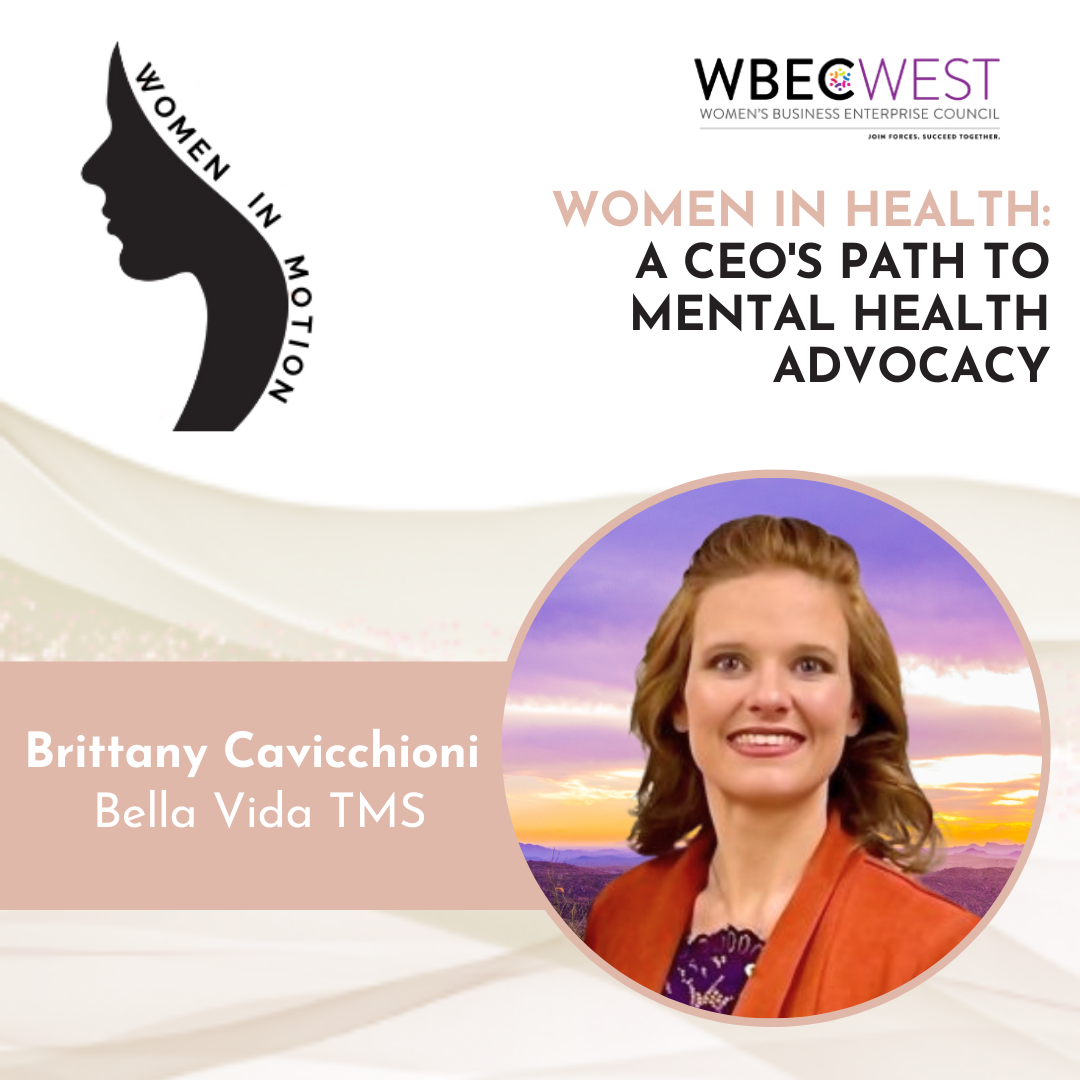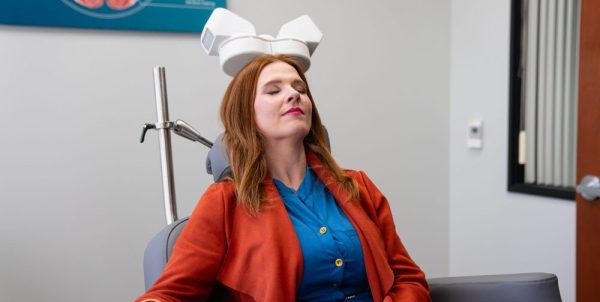
In this episode of Women in Motion, Lee Kantor talks with Brittany Cavicchioni, CEO of Bella Vida TMS, about her transition from a legal career to mental health advocacy. Brittany shares her personal battle with depression and how discovering Transcranial Magnetic Stimulation (TMS) transformed her life. She emphasizes the importance of non-invasive treatments for mental health conditions like depression, anxiety, and PTSD. The discussion also addresses barriers to mental health care, such as education, accessibility, and affordability, and highlights the need for community support and open conversations about mental health. Brittany encourages listeners to explore available resources and seek help.
 Brittany Cavicchioni is the founder and CEO of Bella Vida TMS, a leading mental health clinic dedicated to transforming lives through Transcranial Magnetic Stimulation (TMS).
Brittany Cavicchioni is the founder and CEO of Bella Vida TMS, a leading mental health clinic dedicated to transforming lives through Transcranial Magnetic Stimulation (TMS).
After experiencing firsthand the challenges of traditional mental health treatments, Brittany discovered TMS—a non-invasive, FDA-approved therapy with life-changing potential. Inspired by her own journey of overcoming depression and the profound impact of TMS, she shifted her career from law to mental health, making it her mission to expand access to innovative treatments and break down the stigma surrounding mental health care.
With an entrepreneurial spirit and a deep commitment to patient care, Brittany has spearheaded Bella Vida TMS’s expansion, ensuring that those struggling with depression, PTSD, anxiety, and other mental health conditions receive effective, compassionate treatment.
Beyond depression treatment, Brittany is a strong advocate for the lesser-known benefits of TMS, including its applications for autism, sleep regulation, memory enhancement, and more. She is on a mission to educate the public about this underutilized technology, which has been around since the 1980’s yet remains widely misunderstood. 
Bella Vida TMS has become a hub for cutting-edge mental health solutions, ensuring that patients have access to safe, effective, and insurance-covered treatments. Brittany’s work is driven by a passion for helping others reclaim their lives, a commitment to expanding access to care, and an unwavering belief that mental health care should be innovative, effective, and stigma-free.
In addition to running Bella Vida TMS, Brittany is a social media advocate, speaker, and business strategist, always looking for new ways to empower individuals and transform mental health treatment.
Follow Bella Vida TMS on LinkedIn and Facebook.

Music Provided by M PATH MUSIC
![]() This transcript is machine transcribed by Sonix
This transcript is machine transcribed by Sonix
TRANSCRIPT
Intro: Broadcasting live from the Business RadioX Studios, it’s time for Women In Notion. Brought to you by WBEC-West. Join forces. Succeed together. Now, here’s your host.
Lee Kantor: Lee Kantor here, another episode of Women In Motion and this is going to be a good one. But before we get started, it’s important to recognize our sponsor, WBEC-West. Without them, we couldn’t be sharing these important stories. And this month, we’re highlighting women in health, and so excited to be talking to my next guest, Brittany Cavicchioni. She is the CEO with Bella Vida TMS. Welcome.
Brittany Cavicchioni: Hi, Lee. Thank you so much for having me.
Lee Kantor: Well, I am excited to learn what you’re up to. Tell us about Bella Vida TMS. How are you serving folks?
Brittany Cavicchioni: Of course. So, at Bella Vida TMS, we specialize in non-invasive, non-medication approaches to the treatment of various mental health ailments, like depression, anxiety, PTSD, and things like that. One of our main treatments is TMS, also known as Transcranial Magnetic Stimulation. It’s been around since the 1980s. FDA approved since 2008. Health insurance has been paying for it since 2012. And it has about an 80 percent efficacy rate, which means it’s successful at treating the condition of depression about 80 percent of the time. But still, people don’t know about it. So, that’s what we do and that’s what we’re here for.
Lee Kantor: Can you share a little bit about your journey? How did you get involved in this line of work?
Brittany Cavicchioni: Yes, of course. So, before I got into mental health, I actually worked in the legal field for about a decade, actually changed some laws in Arizona so that non-attorneys can own law firms. A lot of fun stuff. So, my passion really always was helping people, but more so on the legal side of things.
Brittany Cavicchioni: In about around 2021, I was going through a divorce and several other major life experiences, and I found myself battling some pretty severe depression for the first time in my life. It was about as serious as a heart attack, Lee. Like when it happened to me, I wasn’t able to get out of bed in the morning sometimes or get my daughter to school. And for over a year, I was working with a team of therapists and psychiatrists to do some medication management and your typical approaches to mental health, like going to therapy, and nothing was really working.
Brittany Cavicchioni: After a year, a friend of mine actually told me about TMS and it changed my life. Within ten sessions, I was able to start, you know, getting back to work, coming off of the antidepressant medications. And after that experience, one of the things that really puzzled me was, one, why didn’t my writer team tell me about this? It’s been around since the ’80s and my health insurance covered it. And the other thing is, why don’t more people know about it? And I think it simply boils down to there’s a lot more money into big pharma. And so, I switched gears from trying to open a law firm to helping others in the mental health space.
Lee Kantor: Now, for folks who maybe are going through a tough time right now, can you just give us some basic education? Like how do you know when I’m just having a bad day or a bad week or I really might have depression? Are there some symptoms or some things that are happening that is like, okay, if you’re on one side of the ledger, this just means you’re just kind of going through the blues. But if you’re on the other side of the ledger, then you might need some help here.
Brittany Cavicchioni: Right. So, we’re talking about the difference between, you know, situational depression or chronic depression or major depressive disorder that’s treatment resistant. So, a lot of health insurances, they’ll describe depression as sadness. I’ve actually seen it in some of their documents, they say we see that you’ve been diagnosed with depression, also known as sadness.” And I guess that’s a simplified way of explaining it.
Brittany Cavicchioni: The thing is, just like the weather, you know, you have days where it’s sunshiny outside and days where it’s rainy. Your mood can change the same way, right? You can have good days, you can have bad days. But if you’re in that constant state of sadness and it starts affecting your day-to-day activities and your ability to think about other things other than, I guess, that sadness or that depression, that’s when it’s advised for you to seek appropriate medical care and look for other avenues in order to come out of that. If you stay in that state for extended periods of time, that’s whenever you end up with major depressive disorder and it escalates from moderate to severe, and so on and so forth.
Lee Kantor: So, it’s one of those things that if you don’t proactively treat it, it tends to not get better on its own. It’s going to kind of spiral.
Brittany Cavicchioni: Correct. Your brain, just like any other part of your body, if you neglect it long enough, there will be signs and you will be forced to pay attention to it at some point.
Lee Kantor: And then, a typical person going through this, I would imagine, do they have the kind of self-awareness to say, “Oh, I need help” or is this something where their support system, their family or friends says, “Hey, you might need to get help here.”
Brittany Cavicchioni: We actually find it to be a little bit of a combination of both. So, we have quite a few people who contact our offices to reach out for resources for themselves and quite a few reach out for resources for their son or their daughter or an aunt or uncle. So, it’s a little bit of a combination. Sometimes we don’t realize how badly we need help until until it’s there for you.
Lee Kantor: And for folks, I would guess the majority of people go through some sort of a medical path first, is that their inclination is, “Okay. I’m going to go and I’ll ask or I’ll get a psychiatrist or get somebody with medical background.” Is that usually the first move? Or do they kind of maybe go online and try to solve it, you know, by googling it? Like what’s the typical path?
Brittany Cavicchioni: Are you referring to depression or referring to TMS?
Lee Kantor: I’m just trying to give a person who’s listening, like if they’re struggling, how do they try to solve this. And it sounds like you said some people are proactive on their own, some people have help from family members, support system. I’m just trying to understand the path that they’re going and I want to be able to differentiate the path that you’re offering.
Brittany Cavicchioni: Absolutely. So, one of the reasons I started this company was because I felt like the mental health space is just not created for real people with real problems. And so, we do a lot of community resources and community outreach kind of provide that guideline for people. Some people don’t realize that what they’re dealing with every single day is chronic depression.
Brittany Cavicchioni: And so, things that we like to do is, I guess, explain to people or help people make it through, one, identifying, hey, I have a problem. And so, there are things, easy surveys and things like that, that we have on our website, that are generally used in the mental health space to help determine whether or not somebody has depression.
Brittany Cavicchioni: One of the really popular ones is called a PHQ-9 survey. This is used in almost every mental health facility to help support the diagnosis of depression and the degree of depression that someone will have. So, that’s one of the resources that we provide to patients and simply people who question whether or not this is true depression or just, you know, kind of a bad day type situation. So, there are those types of questionnaires.
Brittany Cavicchioni: The other resource that we provide for real people with real problems in mental health is guidance for how to apply for FMLA, and our office will assist with that and things of that nature, because, you know, sometimes it’s hard to make time to go to therapy appointments or time to go to TMS appointments. And so, we help guide people through that process as well.
Lee Kantor: What is FMLA?
Brittany Cavicchioni: FMLA is the Family Medical — or federal? I think, it’s Family Medical Leave Act. Where a lot of people know about it whenever someone gets pregnant and they go out for 12 weeks after they have their baby. You can use FMLA, which protects your job if you have to take any extended period of time off work. So, essentially, we help people a lot of times either take full FMLA where they’re taking that full 12 week leave if they need to in order to care for their mental health.
Brittany Cavicchioni: Or there’s also this thing called intermittent FMLA. So, sometimes it’s not as serious as needing to take off full 12 weeks of work. You just may need to do half days at work or ask for accommodations so that you can work remote. That also can fall under that FMLA approval and paperwork.
Brittany Cavicchioni: So, it’s just another thing that, again, real people who have real jobs, and one of the biggest, you know, issues or barriers to care is that time piece. A lot of people don’t have time. And so, we help them create that time, but also help them keep their jobs. You shouldn’t have to lose your job in order to seek out mental health resources.
Lee Kantor: Now, when they’re working with you and your team, you’re going a non-medical route. Is that your methodology?
Brittany Cavicchioni: Non-medication.
Lee Kantor: Non-medication.
Brittany Cavicchioni: Yeah. It is still very much medical. We have psychiatrists and psychiatric nurse practitioners and therapists on staff. But it’s non-medication. It’s more of a holistic approach to the treatment of depression. We do have some medication options. We provide medication management for people who need it, and that’s kind of their preferred course of treatment. It’s just we want to make sure people are making informed decisions, know all of their options, both on the medication side of things, which is really the traditional mental health treatment route, but also on the non-medication side for things like TMS, and also advanced forms of therapy like EMDR, which I could talk all day about.
Lee Kantor: But I’d like to just understand, so you mentioned kind of big pharma early on, and so it sounded like to me that traditionally the move to make is, okay, I’m going to medicate you in some form or fashion with some antidepressant based on how I see you behaving. And then, I guess we tweak your medication until we hit a point where you feel you’re functional. Is that the normal playbook in traditional treatments?
Brittany Cavicchioni: That’s correct. So me, personally, whenever I was going through my own journey during that year time frame, I had actually trialed four different antidepressant medications. So, yes, that is the typical treatment course to take in a lot of times in the mental health space.
Brittany Cavicchioni: But what I can tell you is that there are studies out there that are, you know, independent studies that you can find online. One specifically that comes to mind is called the STAR*D trials. And what they found out in the STAR*D trials is that, on your first trial of antidepressant medication, you have about, I think, it’s like a 50 percent chance or 40 percent chance that it’s going to be effective. It’s going to work out for you.
Brittany Cavicchioni: If it doesn’t work out and you go on your second trial, that rate of success goes down to, like, 36 percent. And then, on your third trial, if that second one doesn’t work, your rate of success goes down to about 18 percent. And then, on the fourth one, it goes down to less than 10 percent.
Brittany Cavicchioni: So, my question whenever my providers kept trialing me on these different antidepressants, which have very wicked side effects, my question was, you know, why do we keep doing something that’s not going to increase in efficacy or effectiveness, instead of trying something a little bit different, like TMS or Spravato or some other form of treatment.
Lee Kantor: There’s a lot of people, they say the words big pharma and they make it seem like there’s some financial incentive for the provider to be offering these drugs rather than other kinds of treatment. Can you connect the dots for me? Like what’s in it for the provider? Like, are they getting paid somehow by these big pharma? Is that how they make money is by getting a percentage of whatever that pharma bill is?
Lee Kantor: Because I don’t understand how the money goes to the provider rather than the pharmaceutical company. Like, I understand that makes sense to me that they would encourage you to do it, but I don’t understand what the provider gets by encouraging it rather than some other type of treatment.
Brittany Cavicchioni: Absolutely. So, it’s a lot less expensive for the providers to offer something like medication management, because then they’re meeting with the patient for about, you know, 15 to 30 minutes every couple of weeks. They write a prescription and then they move on to the next patient. And they bill that patient, you know, another $100 or so to do the same exact thing over and over again. So, your overhead is a lot lower and your revenue is a lot higher. You don’t really have a whole lot of equipment or anything that you need for those types of treatments.
Brittany Cavicchioni: With TMS, you have clinical staff that you have to pay to render the services. The treatment takes about 30 minutes to 45 minutes, depending on the protocol that you’re using. And then, the machine, the TMS machine itself is typically over six figures just for your initial upfront costs.
Brittany Cavicchioni: So, the pharmaceuticals are a lot more well-known. You have pharmaceutical reps. Even myself, we have pharmaceutical reps that come in every single week trying to push whatever prescription drug that they are representing, versus with TMS, you’re really looking at, I feel like a lot of times, what’s a little bit better for the patient even if it’s not what’s easier.
Lee Kantor: Okay. So, I understand clearer. So, now the pharmaceutical option is just easier on the provider because they’re just handing them a prescription and it gets filled. We see how you’re doing. I ask you a couple questions. That’s easier to manage than having a big piece of equipment in my office that I got to maintain, and I got to train people on, and then I got to hook people up to in order to do the actual treatment, so that creates more overhead for people who are going down that route, even though it might be more beneficial to their patients.
Brittany Cavicchioni: Correct.
Lee Kantor: And so, for you, once you saw the benefits of TMS for yourself, how did you kind of make that leap to, okay, I’m going to build a practice around this. You know, that step is a pretty big step. I mean, it’s one thing to feel good about yourself, like, “Wow, this made me feel better. Hey, why don’t I get one and help other people?” How did you kind of make that leap, because that seems like a pretty big change what you were previously doing and kind of the expertise needed to execute something like that?
Brittany Cavicchioni: Absolutely. So, I appreciate the question. So, prior to this, like I said, I was in the process of attempting to open a law firm. Now, that was always my passion, was opening my own law firm, doing things away. So, as far as the capital that was there, we were good to go there.
Brittany Cavicchioni: One of the main motivations I had for, okay, maybe I don’t need to be another billboard on the I-10 in Phoenix. Maybe I could move forward in some way to help others in a different way. The big motivator for that was my daughter, Bella. She’s now six years old. And when I was going through my battle with depression, like I said, I’m a real person. I don’t have this huge medical background or anything like that. I was reaching out for resources, reaching out for help, and it didn’t seem like that help was readily available to me. I couldn’t make informed decisions because my care team wasn’t telling me about all the treatments available to me.
Brittany Cavicchioni: And so, I wanted to really change the way that we approach mental health. I want to have more conversations like this so that, you know, we can talk about what those treatment options are, but also how to get there through things like FMLA or other things like that.
Brittany Cavicchioni: So, when I was looking at why didn’t I know about this sooner, I found that there were three main issues. So, one, there’s the education piece. So, I knew that we were going to have to need to do more things, like this podcast, or a lot of marketing and things of that nature. We needed to be in places where people wouldn’t necessarily expect mental health providers to be. So, we go to things like home and garden shows and stuff like that for the education piece, to educate the community about this service.
Brittany Cavicchioni: The second piece was accessibility. There weren’t very many providers offering it, and so I wanted to change that. We’re actively working towards getting to ten locations in Arizona. Right now I have two, and we just started last year. So, I want to make it more accessible. We stay as close as we can to the freeways. And we’re in all these large major cities here in Arizona. So, that’s the accessibility piece.
Brittany Cavicchioni: And then, the third issue is affordability. A lot of people struggle to find ways to afford the treatment. And whenever I was seeking out the services in 2022, the places here in Arizona, either they didn’t take health insurance, so people were paying cash pay for this service. And in terms of the cash side of it, if you were to go that route, you’re looking at spending about $20,000 for a full course of treatment.
Brittany Cavicchioni: The places that did take health insurance, they were booked out for three months. And so, I wanted to make sure that we were a provider that not only took health insurance, but took health insurances for all patient populations, so that helps fix the affordability piece.
Brittany Cavicchioni: So, at our clinics, we accept not only, you know, your typical commercial plans like Blue Cross Blue Shield, United Healthcare, things of that nature, but we also accept Medicare and State Medicaid and TRICARE. So, that’s that part as well. So, once I figured out that those were the three main barriers whenever it came to TMS and why more people don’t do it or don’t know about it, everything else, it was pretty easy from there to build that business plan.
Lee Kantor: Now, why was it important for you to get certified and become part of the WBEC-West community? What was the thinking there?
Brittany Cavicchioni: So, I go back to my daughter again. So, I want to show her that women can lead in today’s society, and that we do support each other, and that we can exist in a lot of male dominated fields. So, that was kind of my main motivation to join WBEC.
Brittany Cavicchioni: But then, as I have continued my membership through the services, I find that it’s benefits have exponentially grown. For example, right now I’m on this podcast. I also am looking forward to a few workshops that are coming up where I can connect with other women business owners and learn from them about how they are scaling and improving operational efficiency, and things of that nature.
Lee Kantor: So, what do you need more of? How can we help you?
Brittany Cavicchioni: So, I believe Ella at at your office actually has already helped me a ton in terms of making sure that I got connected to the right people to join those workshops. And then, also, she told me where to go to set up our business, I think, portal or page. So, so far you guys have been absolutely phenomenal. Thank you so much for your support.
Lee Kantor: Now, what do you need from a business standpoint? Do you need more patients? Do you need more kind of the people that do the treatment? Do you need more funding? Is there anything in our network that might benefit you?
Brittany Cavicchioni: We just need more exposure and we need to tell more people about these services, and that there are ways to help real people with real problems get the care that they need without having to sacrifice time with their families or their jobs in order to do it.
Lee Kantor: And then, if anybody has any type of question about TMS, if they’re unfamiliar and would just like to learn more, is there a website or is there a place they can go for more information from you and your team?
Brittany Cavicchioni: Yes, of course. So, our website is bellavidatms.com. That’s B-E-L-L-A-V as in Victor-I-D as in David-A-T as in Tom-M as in Mary-S as in Sam.com. We also post on social media, so we have a TikTok account, Instagram, and Facebook, so whatever way works best for them. They can also reach out to us by phone or text message at 602-610-1191.
Lee Kantor: Well, Brittany, thank you so much for sharing your story today. You’re doing such important work and we appreciate you.
Brittany Cavicchioni: Thank you so much, Lee. I appreciate you guys having me here.
Lee Kantor: All right. This is Lee Kantor, we’ll see you all next time on Women In Motion.














